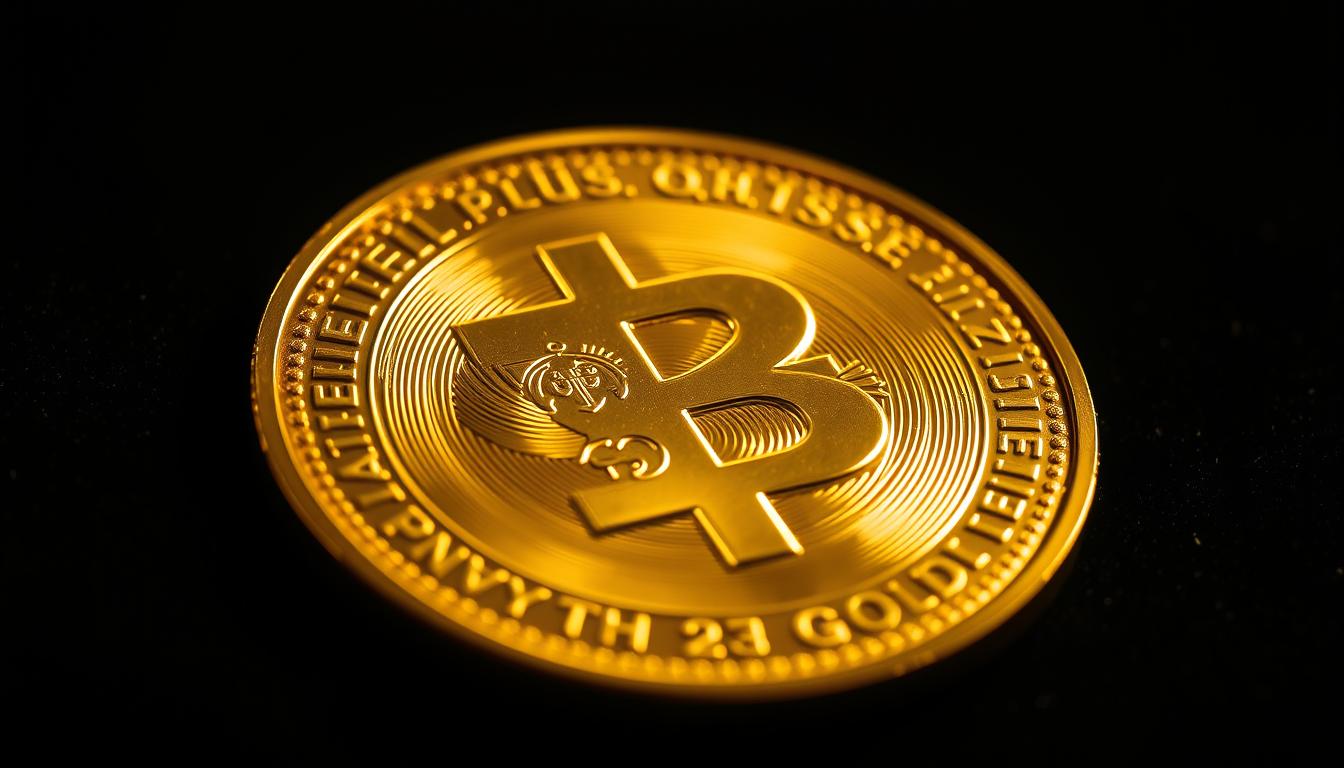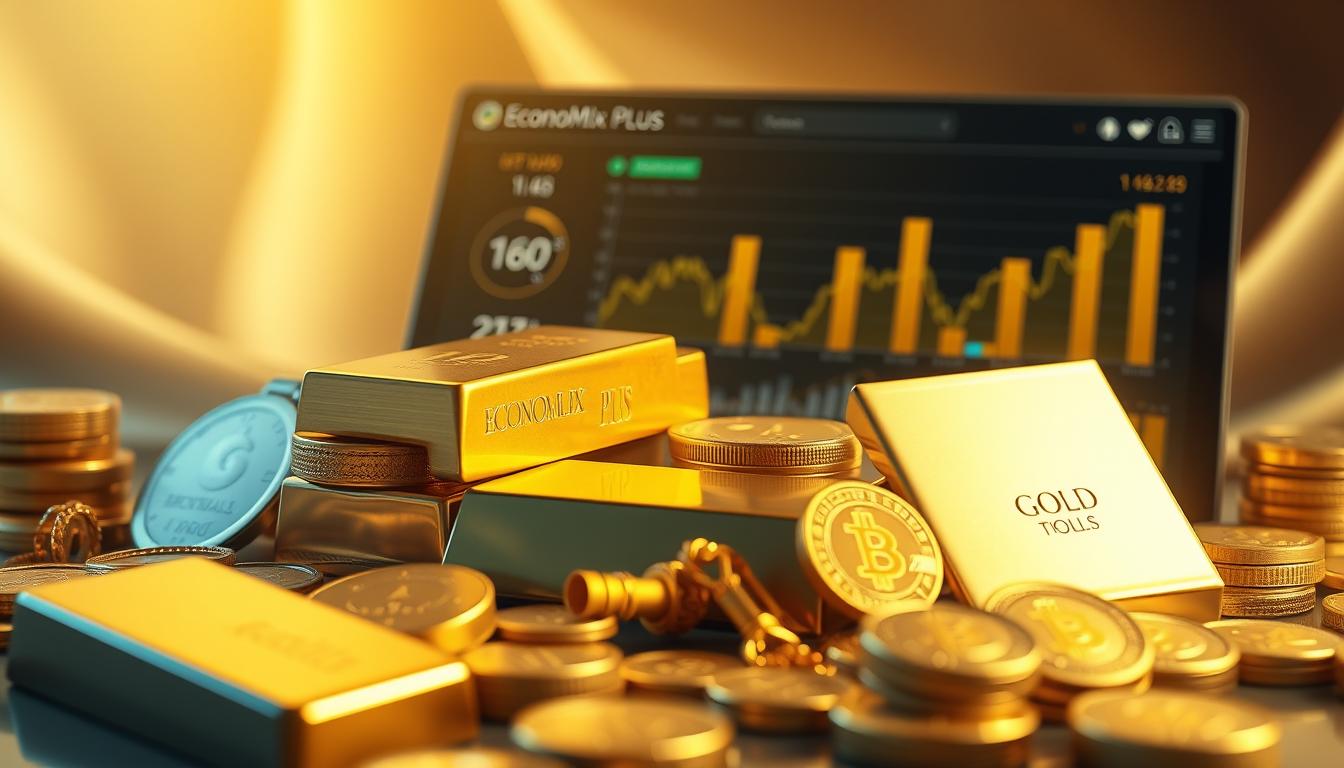In the world of gold investment, you face a choice: paper gold or physical gold. Both are claims to gold, but they differ in ownership, benefits, and market behavior.
Steve Rand, General Manager and Sr. Precious Metals Advisor at Scottsdale Bullion & Coin, says it’s key to know the difference between paper and physical gold. This knowledge is vital for smart investment choices.
This article will explore the definitions, benefits, and market trends of paper gold and physical gold. It aims to help you understand the complexities of gold investment.
Key Takeaways
- Paper gold represents a claim on gold, while physical gold is tangible ownership.
- Physical gold provides a hedge against inflation and market volatility.
- Paper gold is often more accessible and easier to trade.
- Understanding the difference is key for making informed investment decisions.
- Market dynamics greatly affect the value of both gold investment types.
Understanding Gold as an Investment
Thinking about adding gold to your investment mix? It’s a smart move. Gold has been a key part of investment plans for ages. It brings stability and growth to the table.
The Historical Value of Gold
Gold has always been a safe place to keep wealth. It’s a shield against inflation and economic ups and downs. For centuries, gold has kept its value, proving to be a reliable asset in tough times.
Gold’s Role in Modern Investment Portfolios
In today’s investment world, gold is a diversification tool. It helps spread out the risk in your portfolio. Investors put a part of their money into gold to protect their investments.
Why Investors Turn to Gold
There are many reasons why investors choose gold. It’s a safe-haven asset when markets are shaky. Its past performance, the chance for its value to go up, and its ability to fight inflation are all big pluses.
What is Physical Gold?
Physical gold is special because you can touch it and see it. It has been important for keeping wealth safe for a long time. You can even give it to your family in the future.

Gold Bullion: Bars and Coins
Gold bullion is a big part of physical gold. It includes bars and coins that are worth their gold. Coins like the American Gold Eagle are valuable for their gold and their history.
Jewelry and Collectible Gold Items
Gold is also in jewelry and collectible items. These things can grow in value over time. It’s not just the gold that matters, but also the skill in making it, how rare it is, and its history.
Purity Standards and Certifications
When you buy physical gold, look at purity standards and certifications. Gold is rated in karats, with 24-karat being the purest. Mints and refineries check the gold’s purity and realness, making sure it’s good for investors.
What is Paper Gold?
Paper gold lets you enjoy gold’s price swings without owning physical gold. It offers different ways to invest in gold.
Gold ETFs and Mutual Funds
Gold ETFs (Exchange-Traded Funds) and mutual funds track gold’s price. They let you invest in gold without needing to store it physically. Gold ETFs, like SPDR Gold Shares, trade on stock exchanges, making buying and selling easy.
Mutual funds that focus on gold invest in gold-related assets. They offer a mix of investments and are managed by experts.
Gold Futures and Options
Gold futures are contracts to buy or sell gold at a set price on a future date. They trade on commodity exchanges and are used for speculation or hedging. Gold options give you the right to buy or sell gold at a set price, but you’re not obligated.
Gold Mining Stocks
Investing in gold mining stocks lets you profit from gold mining companies’ success. The value of these stocks can rise with gold’s price, but company performance also matters.
Gold Certificates and Accounts
Gold certificates and gold accounts represent a claim on gold. They are issued by banks and other financial institutions. They let you own gold without physically holding it.

What is the Difference Between Paper Gold and Physical Gold
When you think about investing in gold, it’s key to know the difference between paper gold and physical gold. Each type meets different needs and preferences.

Ownership Structure and Legal Rights
Physical gold means you own it outright, with full legal rights. You can store, transfer, and manage it as you wish. Paper gold, on the other hand, is a claim on gold, not actual ownership.
For example, gold ETFs hold gold for investors, but you don’t own it directly. This affects your legal rights and risk exposure.
Liquidity and Accessibility Comparison
Paper gold, like gold ETFs and futures, is easier to buy and sell. You can access it through many financial platforms.
Physical gold is less liquid but can be sold quickly through trusted dealers. It might cost more due to assaying and storage fees.
Cost Structures and Fees
Buying physical gold comes with costs like premiums, storage, and insurance. Paper gold, like ETFs, has management fees, trading commissions, and other expenses that can reduce your earnings.
Tracking Accuracy to Gold Prices
Paper gold, like gold ETFs, usually mirrors gold prices closely. But, fees and trading costs can cause slight differences.
Physical gold, being the real deal, tracks gold prices exactly, minus the costs of buying and selling it.
In summary, knowing the differences between paper gold and physical gold is vital for smart investing. Consider ownership, liquidity, costs, and tracking accuracy to pick the right gold investment for your goals.
Advantages of Physical Gold
Physical gold offers many benefits, from owning it directly to protecting against financial risks. When you think about adding gold to your investment mix, knowing these perks can guide your choices.
Direct Ownership Benefits
One key benefit of physical gold is the direct ownership it provides. Owning gold means you control it fully, without needing banks or brokers. This direct control can make you feel safer and more secure.
Protection Against Systemic Financial Risks
Gold also acts as a shield against big financial problems like inflation, currency drops, and market crashes. By keeping gold, you safeguard your wealth from market downturns.
Privacy Considerations
Investing in gold can also keep your financial dealings private. Gold transactions are often done quietly, and your ownership isn’t always tracked by banks.
Tangibility and Psychological Security
Gold’s physical form offers a sense of comfort to investors. Holding gold can be very reassuring, even when the economy is shaky.
| Advantage | Description |
|---|---|
| Direct Ownership | Complete control over your asset without intermediaries |
| Protection Against Financial Risks | Hedge against inflation, currency devaluation, and market crashes |
| Privacy | Discreet transactions and ownership not necessarily recorded |
| Tangibility | Physical possession providing psychological security |
Understanding the benefits of physical gold can help you make better investment choices. It can also boost your financial safety.
Advantages of Paper Gold
Investing in paper gold has many benefits. It’s flexible and convenient, making it easier to manage your investments. This makes it a great choice for investors.
Ease of Trading and Market Access
One big plus of paper gold is how easy it is to trade. You can buy and sell it through ETFs, mutual funds, and futures contracts. This makes transactions quick and simple. It also lets you quickly respond to market changes.
Lower Storage and Insurance Concerns
Paper gold doesn’t need storage and insurance like physical gold does. This means you save money on costs. You won’t have to worry about finding a safe place to store your gold or insuring it.
Divisibility and Investment Flexibility
Paper gold is also divisible. This means you can invest in gold in smaller amounts. It’s easier to diversify your portfolio and adjust your gold holdings to fit your financial goals.
Portfolio Integration Capabilities
Also, paper gold fits well into your existing portfolio. It can help protect against market volatility, inflation, or currency changes. This makes your portfolio stronger and more resilient.
Paper gold offers many benefits. These include easy trading, lower costs, divisibility, and better portfolio integration. It’s a smart choice for investors looking to diversify and benefit from gold investing.
Performance During Different Economic Conditions
Investors keep a close eye on gold’s performance in various economic conditions. Gold is often seen as a safe haven. Its value changes a lot depending on the economic situation.
Inflation and Currency Devaluation Scenarios
When inflation and currency devaluation happen, gold usually does well. As inflation goes up, the value of money goes down. People then turn to gold as a safe place to keep their money. For example, in the 1970s, when inflation was high, gold prices went up a lot.
Market Crashes and Financial Crises
In times of market crashes and financial crises, gold becomes more popular. People looking for safe investments push gold prices up. The 2008 financial crisis is a good example of this.
Tax Implications for US Investors
US investors need to think about taxes when investing in gold. Gold investments are taxed on capital gains. The tax rate depends on the type of gold investment and how long you hold it.
Regulatory Considerations
Regulatory considerations are also important for gold investments. It’s key to keep up with any new rules that could affect your gold investments. This includes changes to gold ETFs or gold mining stocks.
Knowing how gold performs in different economic times helps you make better investment choices. Whether you’re buying physical gold or paper gold, these factors are important to consider.
- Monitor economic conditions closely.
- Understand the tax implications of your gold investments.
- Stay informed about regulatory changes.
Selecting the Right Gold Investment for Your Financial Strategy
Choosing gold investment requires knowing your financial strategy and goals. You need to decide between physical gold and paper gold. Each has its own benefits.
Think about what you want from your investment. Physical gold is great for protecting against inflation or financial troubles. Paper gold, on the other hand, is easier to trade and store.
Consider your financial plan and what you need from your investment. Look at your liquidity needs, risk tolerance, and how long you plan to hold onto your investment. This will help you choose the right gold for your portfolio.
Choosing between paper gold and physical gold depends on your personal situation and goals. Knowing the differences will help you pick the best gold investment for you.
FAQ
▶
▶
▶
▶
▶
▶
▶
▶
▶












